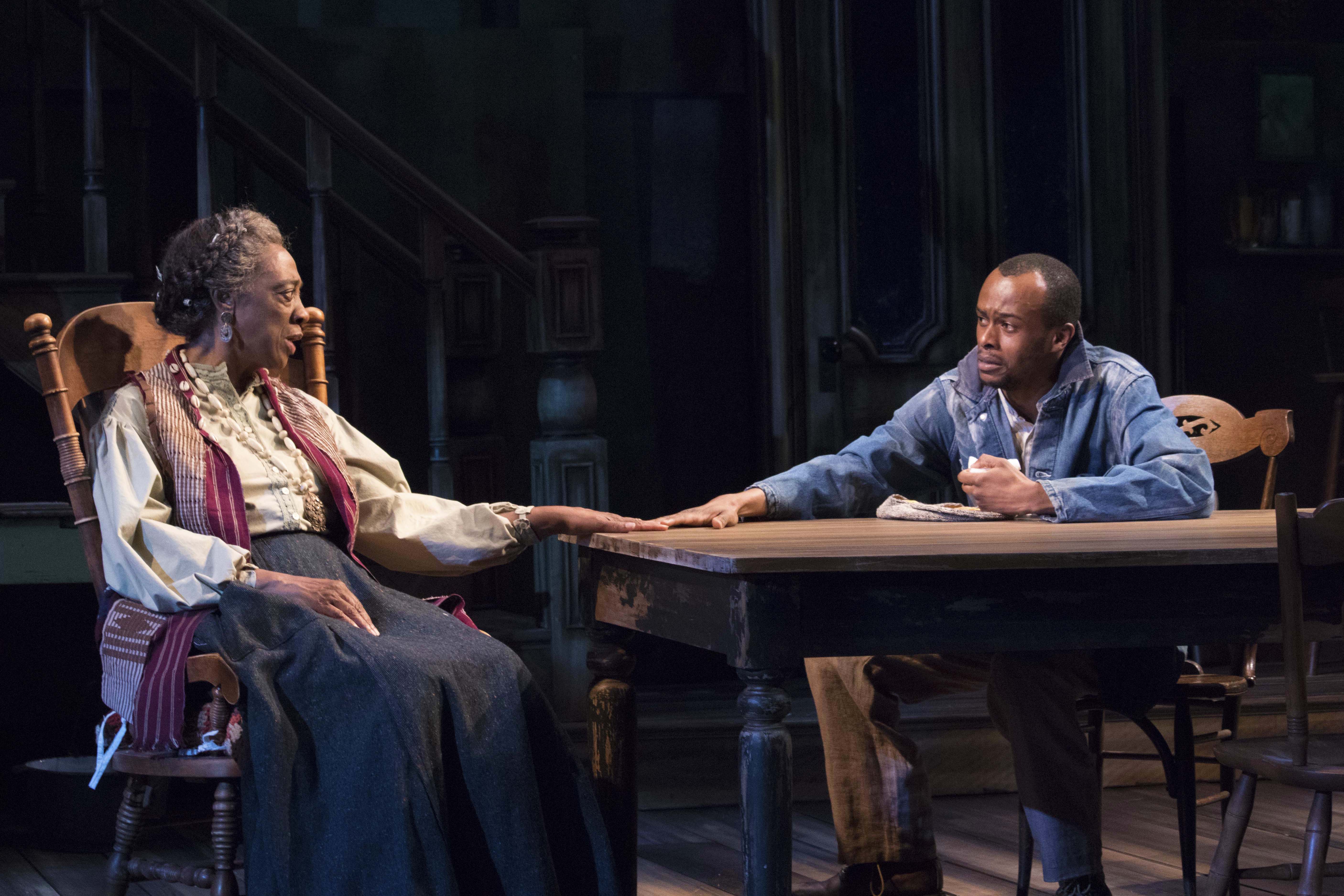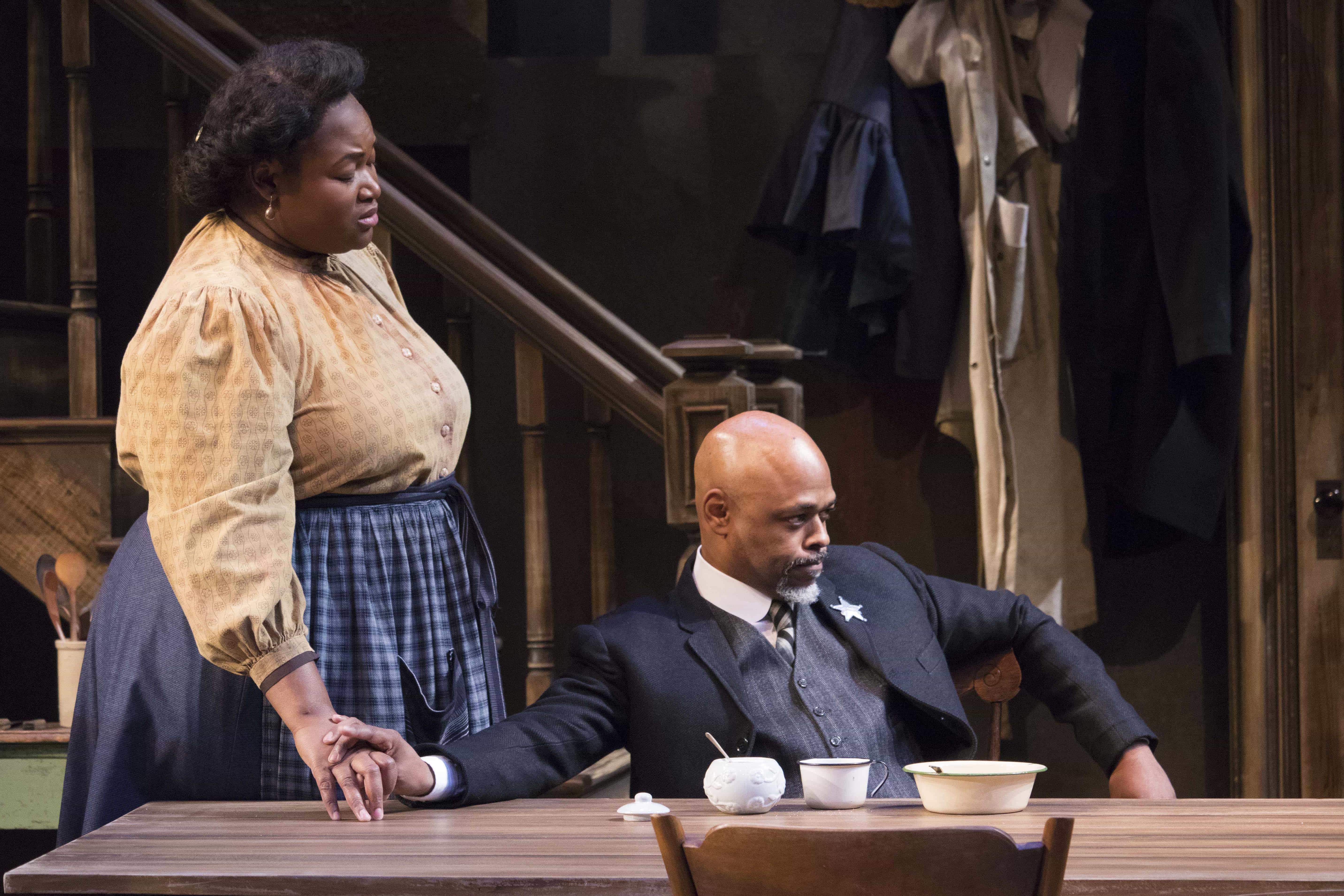There are only ever seven characters onstage in this majestic production—three of them former slaves—but it is as if multitudes of Africans lost crossing the ocean or sold in chains are evoked and recollected with every heartbeat and breath.
August Wilson’s Gem of the Ocean, now playing at Round House Theatre, is the first in his masterwork series of ten plays, which each were framed in a successive decade in the twentieth century (among them such hits as Fences, Seven Guitars, Ma Rainey’s Black Bottom, and Two Trains Running). Gem of the Ocean is set in the Hill District of Pittsburgh in 1904, four decades after Emancipation, in the safe home of a beloved spiritual healer named Aunt Ester, who is here given an exquisitely gritty performance by Stephanie Berry that is reason enough to rush to see this show.

Aunt Ester is nearly three hundred years old, like an ancient in the Scriptures, passages of which she cites often and with passion. She is old enough to remember the crossing that brought her to these shores. She holds on to the bill of sale from when as a girl she was bought by a white man. Her memories matter beyond measure, not only to her but to the whole play:
I got a strong memory. I got a long memory. People say you crazy to remember. But I ain’t afraid to remember. I try to remember out loud. I keep my memories alive. I feed them. I got to feed them otherwise they’d eat me up. I got memories go way back. I’m carrying them for a lot of folk. All the old-timey folks. I’m carrying their memories and I’m carrying my own.
Gem of the Ocean is the first play in the century cycle chronologically but the last one Wilson wrote. And this new production directed magnificently by Timothy Douglas suggests why this powerful play might have been conceived as an essential prologue to the other nine: It is a grand reach back through myth and history that locates in dramatic microcosm and metaphor the black family’s making its way in the world after bondage.
In the lives of seven individuals on stage (and some others off), Wilson encapsulates that family’s collective devastation and points toward a possible future: A time when that family might transcend the immoral horrors of their shared past as possessions, through a hope-filled faith and the self-possessed morale that comes of honoring one another themselves.

That theme is embedded in the central storyline of the play. A distraught young man named Citizen Barlow has traveled from Alabama in order to see Aunt Ester because, he has been told, she can wash souls—and his needs washing desperately because of a wrong he has done. Justin Weeks brings a shattering anguish to the role of Citizen; his voice cracks with yearning for redemption and restitution. And during the course of the play, Aunt Ester does indeed wash Citizen’s soul so he might be right with himself. She has him visualize a voyage to the City of Bones, a sacred place under the sea built of bones by those who perished on the Middle Passage.
Citizen’s soul washing is a scene of astounding stagecraft. The work here of Lighting Designer Andrew R. Cissna, Sound Designer Justin Ellington, and Scenic Designer Tony Cisek is spectacularly moving. Aunt Ester’s humble home, the site of the ritual, is set against a vast wall of oceanic blue fitted with hundreds of votive candles that burst aflame just as Citizen’s soul is saved. And Weaks’s performance in that scene is so wrenching one might well weep along with him.

What’s so salient about that scene to the play’s theme is that it is not about the white-on-black moral abomination of slavery. It is about Citizen’s reckoning with his offense to someone of his original kin. It is about reclaiming a collective memory in order to restore a communal morality that will be crucial for there to be an empowered people in the future.
Wilson’s text is epically lyrical, almost operatic; the speeches are expansive and eloquent, almost arias. And his characters and interwoven storylines are richly textured.
Solly Two Kings (Alfred Wilson) and Eli (Jefferson A. Russell), both former slaves like Aunt Ester, worked together on the Underground Railroad. Eli lives at Aunt Ester’s, helps her out around the house; Solly is an empathic companion who visits often. Rutherford Selig (Michael Glenn), who sometimes drops by, is an amicable white peddler and another friend of Aunt Ester’s. The household also includes Black Mary (Stori Ayers), who mostly cooks and cleans for Aunt Ester and is her protégé in soul washing. It is a “peaceful house,” as Eli always calls it whenever answering the door.
Aunt Ester, who is unfailingly kindly to Solly, Eli, Selig, and Citizen, initially treats Black Mary rather scornfully, berating her for everything she does that isn’t done the way Aunt Ester would have it. The dynamic leaves one uneasy; one wishes Black Mary would not be so passive and would stand up to Aunt Ester. Then finally she does—in a knockout scene that features an awesomely emotionally raw performance by Ayers. When Black Mary is finished, Aunt Ester says simply, “What took you so long?” It is an extraordinary transformational moment, not only in their mentor-mentee relationship but also in the play as a whole because it shows two women rejecting residual master-slave dominance and beginning to get right with each other.
There is a touching scene later between Citizen and Black Mary. He is now right with himself since his soul washing. She is now right with herself since her dignity assertion. And together they reveal a tenderly affectionate attraction to each other. It is a moment that Weaks and Ayers depict so beautifully one wants it not to end. And it is another pointer in the play to a future where love between a black man and a black woman might be equal.

As an ethical counterpoint, Wilson introduces a disruptive character named Caesar Wilks. He is Black Mary’s brother but he is decidedly on the side of the white man’s law, a sheriff who would crack black heads if his job required it. KenYatta Rogers’s performance in the role is formidable; his cunning, unnerving; his apoplectic rages, breathtaking. And the play leaves no doubt about the danger such residual allegiance to The Man man poses to the black family’s embodied integrity.
Between scenes, we hear haunting original compositions by Justin Ellington, music-directed by Darius Smith. Kara Harmon’s costumes and J. Jared Janas’s wigs underscore the credibility of Wilson’s characters with a fine sense of historicity. And Kasey Hendricks’s impressive props play critical roles in the story—Solly’s walking stick with a notch for each escaped slave he got to Canada, Aunt Ester’s quilt that’s a map to the City of Bones, her bill of sale that she folds into a paper boat in which Citizen can sail to the place where his soul will find peace.
One cannot imagine a version of August Wilson’s vision more worthy, and more worth immersion in, than the splendid production of Gem of the Ocean now playing at Round House. It stirs the heart with respect and reverence…and bears profound witness to the bottomless sorrow that was bondage.
Running Time: Two hours 45 minutes, including one intermission.
Gem of the Ocean plays through December 30, 2018, at Round House Theatre – 4545 East-West Highway, in Bethesda, MD. For tickets, call the box office at 240-644-1100, or purchase them online.





I have always been taken by John’s writing, demonstrating his deep knowledge and abiding love of theater, but this review of Gem of the Ocean makes me want to put down everything I am doing here in Miami (touring a production of Vaclav Havel’s play Protest) and rush back to see this production of August Wilson’s play at the Roundhouse. It sounds “pitch perfect” in every way. The performers, the direction, and the vision. Wilson’s 10-play epic of the African American experience may be the most important dramatic work in America. I think this one might go towards redeeming us all.
Thank you for your kind words, Susan.